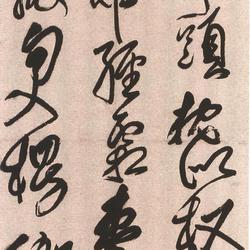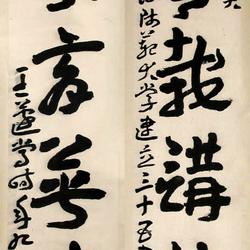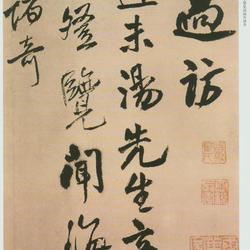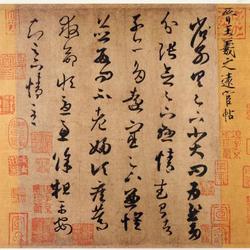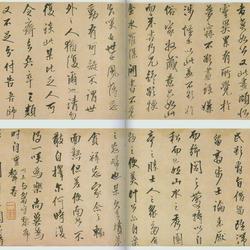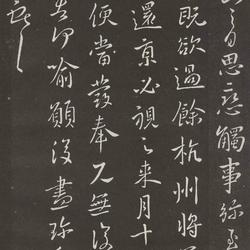Explanation:
Yundingshan Poetry. The mountain dominates the peaks, and the temple occupies the top of the purple cloud. Traveling to the west, I came to Jinquan, climbed the mountain and returned to Zhen slowly. Yesterday evening, I went to school for three days. When I came out of the valley, my neck was stretched. The name of the mountain is Gao Jian, looking back at Huqianling. Climbing is difficult. This day will last forever. The towering stone city emerges. Step by step, the path leads to a loose path. Thousands of couplets in Qingxiao House. Looking down at the border of Erchuan. The jade barrier is connected with the golden geese. Xixuan Lieqian. Zhen. boundary. Qingcheng and Min'e. The sky is covered with dusk clouds. In the white smoke of Shaocheng. Ink and light shadow. Jiang Liu practiced with him. No more fishing boats. To the east is Zitong Pass. On the right side is Jinchuan. The pan is thrown off and the stone does not turn. Withered bark and bright leaves. The fourth watch has not yet come out. The wind is tight in the Hui tent. Guests do bad things. At this point, everyone is worried about the screen. Traveling abroad for the time being. Chatting comfortably and calming the mind. Wujiang Road, Ming Dynasty. Embarrassed and chased by the scene. The first year of Jingguo's founding. July 24th. Cuiwei layman's title. The Qing Dynasty continued for many years. Enjoy real comfort. Beyond the dust. They all have their own pavilion names. Record the verses. No good news. It's hard to escape the old lessons. The old manuscript does not exist. Still memorable. Rain does not dampen deeds. The clouds still rely on the old mountain. Look at the clouds to wake up drunk eyes. Return to the boat by moonlight. The third watch of the water. A boat in the smoke. The cold pavilion is very different. The shadow brings chaos to the mountains and rivers. The twilight smoke and Qin trees are dark. The sun sets over Weichuan River and the sun shines brightly. The flat forest reflects the sun. Wild grass has a short menstrual period due to cold. The frost-dried leaves drifted away. The water from the stone is clear and shallow. The official's coldness is related to the affairs of the officials. The earth prefers to visit the leisurely people. A horse spring breeze passes through the light rain. The road home from bamboo leisure is quiet and dustless. Gulls and herons flew up in alarm. Water chestnut flowers bloom in the autumn wind. One path leads to Zhongzhu. Just sit and hear the chirping of birds. Water clouds are everywhere. I am often afraid that the world will be obsessed with me. The green path is unmarked. The green moss is still dewy. I once dreamed of a spring pond with green grass. Occasionally come to Wuxi to see the red flowers. No one is closed. The moon is the lamp in the middle of the night. Dawn dew condenses on the path. The setting sun paints the bridge. Stay awake listening to bamboo rain. Lying on a high pillow, the wind is turbulent. The bridge crosses the clouds and the ravine connects to the direction. Playing chess in the middle of the night under the dark light of the rain. Microwave to cool down. Light smoke grows distant trees. The weather is cold and the water in Hunan is autumn. The rain is dark and the sky is dark. I have spent many months forgetting to return home. Often with frost and dew. Natural gulls kiss. I met a fisherman and a woodcutter. The thought of leaving has become a thousand miles away. It's hard to get drunk even if you're deep in sleep. Baling leaves fall in the autumn wind. Endure the frost and count the flying geese. It's been written down roughly. But the whole chapter was forgotten. The language is not good. It is also a matter of one's heart and soul throughout one's life. Old friends will pity their separation. The wind has long been thought to be sent. Goodbye Shaopeng. There is also a third volume. Also missing. The letter is unspeakable. It won't be there. I don’t know where I lost it. How how. There are many green pines in Zuomian Mountain. The customs are cheap. Only for woodcutters. Junzhai. No. Monkscha. Not one. Too much rest. He often satirizes Tongshou Jin Bo's transplantation. Make people know it is valuable. Dongchuan is more than a hundred miles away. Entry is no longer possible. Jin Bo thought it was a benefit. Come along the stream. So far all alive. Write a poem to express your gratitude. He also served as Jian's teacher, Dao Shijun. Enter Shaopeng. The seeds were planted in rows under the King of Yue's building. A reed sail came out of the water. It may take a thousand years to do it. The seal has been proud of Jiuqiu Shuang. With the wind, there is the rhyme of Sheng and Yu. With the rain, the jade dew shines. Avoid being a cigarette hut. Down. end. Huaxuan is free and the clouds are growing. Tongquan calligraphy came from official slaves. I hate being near the pond every day. Double carps can be practiced without any effort. A few lines are just hard pornographic books. Where is Sanqin Road at Xiangguan? Horses travel thousands of miles over the years. Thank you to the guests at Yuhua Palace. The new poem does not reveal the old feelings. and Jujiyun. Linchi Tongquan. Because the rhyme is like a word. It's not a bad thing. Don't laugh, don't laugh.
Xue Shaopeng, whose date of birth and death is unknown, was born in Chang'an (now Xi'an, Shaanxi Province). He was a calligrapher in the Northern Song Dynasty and a native of Shenzong of the Song Dynasty. His courtesy name is Daozu and his name is Cuiwei Jushi. The son of Duke Xue Xiang, he is famous for his calligraphy and ink writing. He calls himself a descendant of Sanfeng in Hedong. The official went to Mi Pavilion to compile it and published it as Zi Tong Cao. At that time, he was famous for his calligraphy and calligraphy, and he was good at criticism and appreciation. As a friend of Mi Fu, he always appraises each other and evaluates his gains and losses. Zeng carved Sun Guoting's "Book Book" and handed it down to the world, and later generations recommended it as the refined version. Mi Fu said: "Xue Shaopeng and Yu had the same love for calligraphy and painting. When they asked questions, Yu played and answered them with poems." Shi Yan Mi Xue or Xue Mi is like a brother or brother. "The calligraphy is straight, straight and cursive, and the writing is clear and smooth. It follows the standards of the Jin and Tang Dynasties. Calligraphers have always spoken highly of it. It is as famous as Mi Fu and is known as "Mi Xue".
Song Gaozong's "Han Mo Zhi" says: "Su, Huang, Mi, and Xue's writing styles are full of power and interest."
"Tao Yuan Xue Gu Ling" written by Yuan Yu says: "Mi Yuanzhang, Xue Shaopeng and Huang Changrui are the only ones who know the ancient method. Changrui's book is not good, but Shaopeng is the best." It also says: "The ink postscript of Nandu was written by Domi. , and Xue Youyazheng has the most temporary posts in the "Ye Tie", so it is bound to be a good thing, but it is also rare in the world."
Mengfu of Zhao Dynasty in the Yuan Dynasty said: "The books of the Taoist ancestors are like the kings and the children of the Xie family, and they have the habit of being romantic." He also said: "It is not great to break away from the Tang and Song Dynasties and follow the ancient times!" He also said: "Xue Shu is sincere and beautiful, with a slight hint of authenticity. There is no suspicion of imitation." Ming Weisu said: "The one who surpassed the Tang Dynasty and uniquely captured the writing style of the two kings is Mo Shaopeng Ruo."
Zhang Chou of the Ming Dynasty said: "Xue Shu closely hides the front, which is popular with people in the Jin and Song Dynasties. He cherishes the charm of Shao Shao." He also said: "The laws are strict and there are few changes. The quality is under Haiyue Weng. Liu Jing and Wu Shuo would not have dreamed of it. .”
"Book Summary" says: "The Taoist ancestors wrote down the methods of the two kings, but their transmission is not as good as that of Gao Zhengchen, Zhang Shaoti and others of the Tang Dynasty. This is because Su and Huang Fang were still promoting reforms at that time, so those who followed the Jin method are not as good as what they wrote. "The Louguan Poetry" is so elegant and elegant that it will be famous for future generations."
Weisu of the Song Dynasty praised his book: "Mo Shaopeng is the one who surpasses the Tang Dynasty people and has the unique writing style of the two kings."
Xue Shaopeng's "Miscellaneous Books" (part of it) The extant writings collected by the National Palace Museum in Taipei include "Poetry Volume", "Lanting Lin Manuscript", "Yesterday Tie", "Suishi Yin Tie", "Qinghe Tie", etc. "Yesterday's Post", paper, running script. The length is 26.9 cm and the width is 29.5 cm. "Coral Gang", "Shigutang Calligraphy and Painting Collection", "Shiqu Baoji Continuation" are recorded. It was once engraved in "Sanxitang Dharma Notes". Collection of the National Palace Museum, Taipei. This post is also known as "Demi Lao Shu Tie". The cursive writing of this letter is very legal, and the writing style hides the edge, which is straight but not exposed; the structure is flat and straight, although it is flowing but not hurried, the letter spacing is loose, and the pattern is clear, which is similar to the pattern of Yang Ningshi's "Leek Flower Tie" of the Five Dynasties. The composition is of ancient times, with each word broken up and not in a continuous manner, such as Wang Xizhi's "Seventeen Posts" and Sun Guoting's "Book Book". From this we can get a glimpse of Xue Zhaopeng's practice in the Jin and Tang Dynasties. Therefore, it can be said that the origin of Xue's calligraphy can be traced back to Wang Xizhi's calligraphy, such as "Sixteen Posts". Song Weisu's postscript to Xue Lin's "Preface to Orchid Pavilion": "The famous calligraphers of the Song Dynasty include Cai Junmo, Minangong, Su Changgong, Huang Taishi, and Wu Liantang. However, they surpassed those of the Tang Dynasty. The only one who has the writing style of the two kings is Mo Shao. Peng Ruoye."

